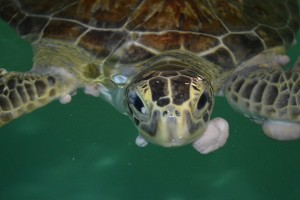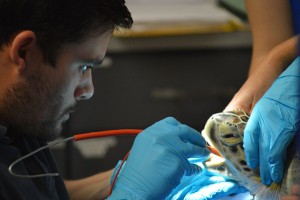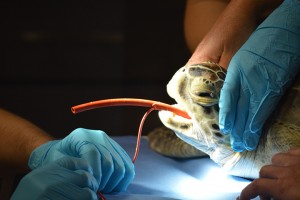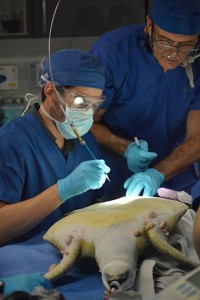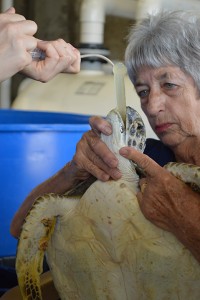In early 2015, I partnered with the Clearwater Marine Aquarium to do a photo story on the sea turtles they rescue, rehabilitate, and eventually release back into the wild.
The work the veterinarians, sea turtle biologists, volunteers, and entire staff undertake on a daily basis is nothing short of amazing.
Enjoy the following photos. I know I experienced a great deal of emotion capturing these moments.
The Clearwater Marine Aquarium has had an influx of green sea turtles affected with the fibropapilloma virus, a disease that causes rampant tumor growth. The tumors, if left unchecked, can hamper the turtle’s ability to swim, make the ingestion of food more difficult, and even cause them to go blind.
Located in Clearwater, Fla., the aquarium has helped rehabilitate and release 370 sea turtles since 2010. From their website, the Clearwater Marine Aquarium is, “a nonprofit working marine rescue center dedicated to inspiring the human spirit through leadership in education,research,rescue, rehabilitation and release.”
Pictured is Montego, a juvenile green sea turtle suffering from extensive tumor growth from the fibropapilloma virus.
“Quimper”; a juvenile green sea turtle:
Veterinarians from the University of Florida prepare Quimper, a green sea turtle, for exploratory surgery to locate a fishing line the turtle ingested. Aside from fibropapilloma, many turtles rescued from local waters around Florida can suffer from boat strikes, pneumonia, and fishing hook and line ingestion.
The veterinarians prepare to cut through Quimper’s shell after they located the collection of fishing line lodged in the green sea turtle’s abdomen. The collections of tumors from the fibropapilloma virus can be seen clearly when the turtle is on its back.
The external tumors can be removed with relative ease, but internal tumors are too difficult for the doctors to remove without putting the turtle in serious risk.
“Dolphin”; a juvenile green sea turtle:
In the quarantined section of the turtle rehab area at the Clearwater Marine Aquarium (CMA), some rescued turtles are too weak to eat solid food on their own. In order to keep the turtles from starving, they are routinely tube-fed by sea turtle biologists until they are strong enough to move on to solid food. The average rehabilitation time for any given turtle can range from six months to more than a year.
In this photo, Dolphin, a green sea turtle, is held by one of the many volunteers at the aquarium. The tube feedings are being administered by Cassie Edelman, a sea turtle biologist with the CMA.
“Ozzy”; a juvenile Loggerhead sea turtle:
Ozzy, a Loggerhead sea turtle, peaks her head out from her tank in the rehabilitation area of the CMA. Ozzy suffered from a broken front flipper caused by a crab trap. She was brought to the CMA in late 2013 and is getting closer to being released. Ozzy is the only Loggerhead the CMA is rehabilitating at this time.
Sea turtles are extremely sensitive to their environments, and often return to the place of their birth to reproduce. Returning the sea turtles back to near where they were found is important for the rescue and release to be effective.
“ California”; a juvenile green sea turtle:
California”; a juvenile green sea turtle:
California, a remarkably photogenic sea turtle, came to the CMA in December 2014. She was found on Florida’s east coast, and was also suffering from the fibropapilloma virus. Since her stint in rehab, she has been cleared of tumors and was released on the east coast on March 26th, 2015.
On March 26th, 2015, the CMA released 3 fully rehabilitated sea turtles at Honeymoon Island State Park, in Dunedin, Fla. The fourth turtle, California, was also released on this same day, but on the other coast where she was rescued.
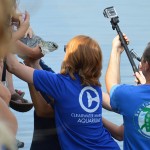
Charger, a green sea turtle, was the victim of a boat strike. He is the only green sea turtle released on the Florida’s west coast on this release.
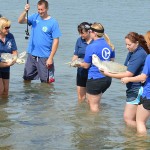
CMA staff and volunteers walk the three sea turtles into the shallows. Turtles pictured (from L to R) are Ricky Bobby, Charger, and Yoda.
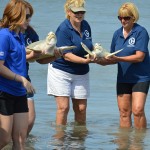
Yoda (L) and Ricky Bobby (R) are both Kemp’s ridley sea turtles who were rescued in 2014. In preparation for their release they appear to pose for the crowd which gathered to witness their last moments before freedom.
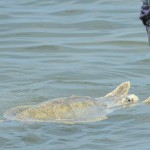
Ricky Bobby, a Kemp’s ridley sea turtle, floats in the water just after release. When he arrived at the CMA on July 26, 2014, veterinarians discovered he had ingested two hooks and also had some shell damage, most likely from a boat strike.
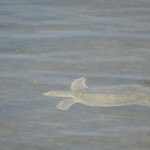
Yoda, a Kemp’s ridley sea turtle, is seen swimming along the sea wall shortly after release. Yoda was suffering from a case of pneumonia when he was found in November 2014.

